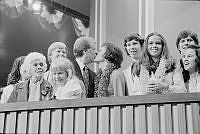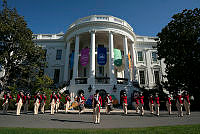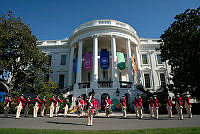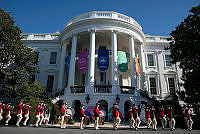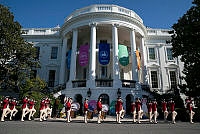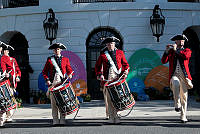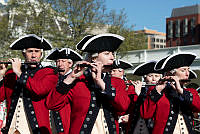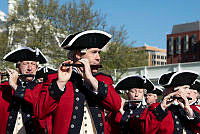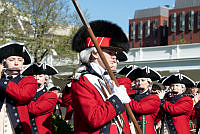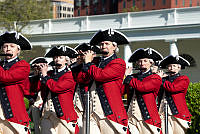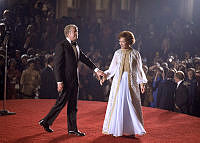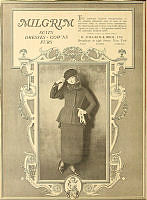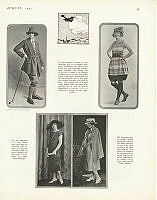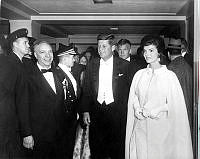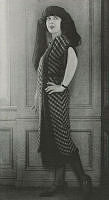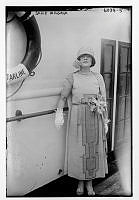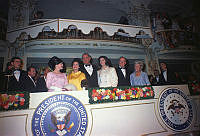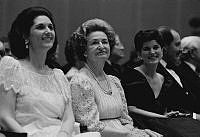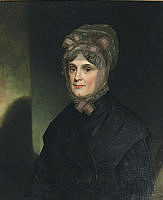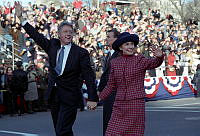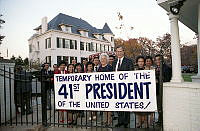Getting It Right
The Embellished Obligations of Dolley Madison
Copyright © June 01, 2014 White House Historical Association. All rights reserved under international copyright conventions. No part of this article may be reproduced or utilized in any form or by any means, electronic or mechanical, including photocopying, recording, or by any information storage and retrieval system, without permission in writing from the publisher. Requests for reprint permissions should be addressed to books@whha.org
On March 4, 1809, at Washington’s first inaugural ball, one keen local observer recorded that the new first lady, Dolley Payne Todd Madison, who arrived draped in a low-cut, buff velvet gown with a long train, “answered all my ideas of royalty.”1 And in truth she did have a uniquely American interpretation of regality that would keep her center stage for the eight stormy years of her husband James Madison’s presidency.
More than anyone else, Dolley Madison shaped the social life of a fledgling capital city eager to create appropriate procedures and rituals to define the highest level of conduct in its grand but still risky experiment in republican government.2 Some elements of her costume—the fashionable, classically inspired silhouette of her gown, its off-white color, the lush velvet material, and the long train—were borrowed from the courts of Europe. But her crown was a turban festooned with bird of paradise feathers, and the royal jewels were a simple set of pearls.3 As one admirer concluded, “Her demeanor is so far removed from the hauteur generally attendant on royalty, that your fancy can carry the resemblance no further than the headdress.”4 Given the highly charged political atmosphere in the city, Mrs. Madison had detractors, but the majority liked the first lady too much to complain about the length of her trains.
Dolley Madison earned lasting fame for her courage during the War of 1812, when she remained in the White House long enough to preserve the cabinet papers and to save the life-size portrait of George Washington from the mockery of the advancing British soldiers.5 Her respect for the portrait as a patriotic symbol showed a keen sensitivity toward Americans longing for emblems that would identify their nation and bind them as a people to it. Ladies of her era were expected to avoid the public face of politics, but even Dolley Madison’s primarily social role placed her in a position to bypass the rule. During the presidential campaigns of 1808 and 1812 she bravely faced the political opposition’s vicious attacks on her husband’s character with unflappable grace and dignity. “By her deportment in her own house,” wrote one contemporary, “you cannot discover who is her husband’s friends or foes.”6

Mrs. Dolley Madison's portrait.
White House Collection/White House Historical AssociationDolley Madison never traveled to Europe to learn the stiff formality of diplomacy in royal courts. She was home-grown, home-schooled, and down-to-earth, and she refined her public persona in the parlors of the new capital city that was to give her fame. James Madison and his consort, opposites in appearance, became Washington’s most powerful couple. Determined to advance Madison’s career, Dolley Madison used the years as wife of the secretary of state (1801–9) to master the right balance between high style and simplicity, appropriate displays of rank, and warm personal accessibility. One admirer, Congressman Henry Clay, is supposed to have said, “Everybody loves Mrs. Madison,” and her reply, “That’s because Mrs. Madison loves everybody.”7
The intellectual James Madison looked younger than he was; small and thin, he was somewhat stiff in crowds, but glowed in small gatherings where he could relax and display his considerable wit. Dolley Madison loved the crowd, never forgot a face or a name, delighted in matchmaking, and readily disarmed critics who were determined to dislike her. One female observer sniffed, “She loads herself with finery and dresses without any taste.” But once in Dolley Madison’s company, the appraisal softened: “Her face expresses nothing but good nature. It is impossible to be with her . . . and not be pleased.”8
The federal capital in 1809 needed some pomp and ritual to illustrate its role as seat of the nation. As president, Thomas Jefferson believed weekly White House “levees” were too Old World aristocratic, and, dismissing the practices of his two predecessors, he opened the White House to the public only on the Fourth of July and New Year’s Day, as well as daily for tours. Inside the mansion, the widower Jefferson preferred small and intimate stag dinners—alternating between Federalists and Republicans—where he carefully controlled the conversation. Jefferson’s studied informality backfired in 1803, when he offended arriving British Minister Sir Anthony Merry by receiving his credentials wearing casual dress with his slippers “down at the heels.” Soon thereafter, he snubbed the arrogant Mrs. Merry at a White House dinner. The diplomatic snafu did not help the United States in its efforts to trade as a neutral country in the ongoing war between Britain and France.9
Congressmen in a half-built Washington were tired of living in boardinghouses and taking their meals in a common “mess,” with few spouses in residence. Foreign ministers accustomed to conducting political business in social settings sought in vain for outlets to perform their duties. Many early visitors to Washington condemned its desolate appearance and lack of amenities. Such criticism rankled lawmakers and officials alike.
Dolley Madison never traveled to Europe to learn the stiff formality of diplomacy in royal courts. She was home-grown, home-schooled, and down-to-earth, and she refined her public persona in the parlors of the new capital city that was to give her fame.
The Madisons had learned that Washington was a company town with politics its only industry. The high turnover in congressional representatives worked against residential continuity among the electorate. As the ranking wife in the Jefferson cabinet, Dolley Madison cultivated wealthy permanent residents—the Tayloes, Maria Van Zandt, Sir Thomas Law, and the William Thorntons—to build a stable foundation for a new official “social” order. Masterfully, she drew the local gentry into the White House and thus into the vortex of politics, the meat and potatoes of daily life in Washington. Madison’s superb wine cellar was a distinct asset, and his wife was a gracious hostess who diligently returned all social calls, an exhausting practice that she continued as first lady. Mrs. Madison had “dove parties” for the women and quietly built a petticoat army to support her social efforts. She would need them to help convince Congress to remain in Washington after the British burned the public buildings in 1814.10
President Madison immediately put his wife in charge of the White House and its entertainments. The first lady reestablished weekly receptions—renamed “drawing rooms” instead of the aristocratic terms “levee” or “salon.” She extended the social season during the congressional session from six weeks to ten. A proper introduction ensured a warm welcome. The Madisons’ held frequent dinners—large affairs seating thirty or more people—where they mixed political parties, members of government departments with diplomats, and a few interesting local visitors for spice.
Mrs. Madison sought out assistants to help with her duties. Management of the domestic structure of the house she placed in the hands of Jean-Pierre Sioussat, an experienced steward from France. He managed the servants, some of whom were African American, such as John Freeman, the butler, and the slaves brought from Montpelier, the Madison farm in Virginia, including Sukey, Dolley Madison’s maid, and Paul Jennings, the president’s youthful valet (“body servant”). There appear to have been some twelve or fourteen servants in all, under Sioussat’s management.

Madison’s dinner invitations were blanks like this one. Dinners were designed unfailingly with politics in mind, and thirty or forty were seated at table. After dinner, Madison was likely to lead the men behind the closed doors of the Green Room to talk politics. On the night of February 11, 1812, when Judge Joseph Hopper Nicholson was invited, they undoubtedly discussed the coming war—of which the judge greatly approved.
On quite a different level, Dolley Madison needed the services of someone to design and supervise decoration of the home. The house Jefferson left was fully furnished but apparently not up to her stylish standards. She turned to the talented British-born architect B. Henry Latrobe, and they spent all of a government housing allowance decorating three rooms in the White House, which became the main areas for entertaining. The interiors showed classical inspiration, with the central oval room (today’s Blue Room) outfitted with American-made klismos chairs of Greek inspiration and benches suitably painted with the Great Seal of the United States. Bright color and light suffused the rooms. Mrs. Madison’s parlor was boldly yellow. Red silk velvet curtains and chair cushions in the oval room, lighted by gilt bronze Argand oil lamps reflected in large looking glasses, created a dazzling stage set for the Madisons’ new, stylish entertaining.11 The first lady added brackets in the shape of eagles as a patriotic touch. It is telling that she also saved the red curtains and the eagles from the flames in 1814.12
Mrs. Madison’s first drawing room was held on May 21, 1809. Not until New Year’s Day was the redecorated oval room ready for use. The President’s House quickly became the centerpiece for social life in the capital. In 1811 visiting author Washington Irving was nearly blinded when he “emerged from dirt and darkness into the blazing splendor of Mrs. Madison’s drawingroom.”13Latrobe and Dolley Madison had worked hard to achieve precisely this effect, not to satisfy personal taste but as a background for the presidency.
Dolley Madison circulated at her parties, leaving the president, dressed in formal small clothes, to discuss politics in a corner. She glided smoothly from guest to guest, providing introductions, remembering even the most distant kinships, and making everyone feel at home in the people’s house. Tall and plump with excellent posture, the first lady had a commanding presence. To enhance her looks in lamplight, she rouged, a risky practice when applied color was associated with less refined women. The formal wardrobe trappings borrowed from European court traditions were offset every time she took snuff, openly blowing her nose on a common bandanna “for the rough work,” before using a linen handkerchief as her “polisher.”14 She invited pretty young belles for the season to play her piano and guitar and entertain bachelor government officials. She even organized the first White House wedding, when her widowed sister Lucy Payne Washington wed Supreme Court Justice Thomas Todd in March 1812.15

Dolley Madison was the first wife of a president to fully embrace her
role as first lady. Her weekly levees at the Presidents House were a
politically neutral space. One visitor wrote of entering the blazing
splendor of Mrs. Madison's drawing room, designed by Benjamin H.
Latrobe, and filled with political, military, and social figures of the
day.
The handsome naval officer, Stephen Decatur, stands center, talking to
Dolley Madison in pink. Other guests include local gentry from the
district, Maryland, and Virginia and a mix of congressmen and senators.
Congressional politics could be very confrontational at the time, so Mrs. Madison used her elegant costumes to encourage a decorous tone during public activities in the White House. The first lady’s love of fashion was undoubtedly a reaction to Quaker restrictions against fancy dress and bright colors that she respectfully followed before her 1794 marriage to Madison. She was banned from the Society of Friends.16 The devoted president decided to invest a part of his $25,000 salary in her wardrobe. He would need the money, because Dolley Madison happily enlisted her family, friends, and foreign envoys in search of dresses and accessories in the then-fashionable Empire style of Napoleon’s France.17
Descriptions of the first lady’s ensembles at important functions abound, but few documentary details about what she actually purchased have survived. Dolley Madison sent a large order to Paris in 1811, and in November wrote to Ruth Barlow, then en route to the French capital, “As you have everything that is beautiful; & we have nothing . . . send me by safe Vessels—Large Headdresses a few flowers, Feathers, gloves & stockings . . . or any other pretty thing, suitable to an Economist & draw on my Husband for the Amt.”18 William Lee, the American chargé at Bordeaux, asked for help with the order. Victoire Delacroix, widow of Charles Delacroix, minister of foreign affairs under the Directory, and her daughter Harriett, wife of diplomat Raymond de Verninac, made sure the costumes were au courant.19
Lee studied French fashion magazines and then set off to “waddle round Paris” assembling her wardrobe.20 Madison must have balked at the $2,000 cost, a staggering sum at that time, and about eight percent of the president’s annual salary. The first lady was left to lament, “I am afraid I shall never ask for anything more.” Dolley Madison was most grateful to Lee but had to set aside the “heads” until she could enlarge them for the next season. The shoes were a size too small; did she wear them anyway?21
Congressional politics could be very confrontational at the time, so Mrs. Madison used her elegant costumes to encourage a decorous tone during public activities in the White House.
The colors of the first lady’s ensembles were sometimes as brilliant as her red velvet drawing room curtains. Ladies’ dresses at the time were high waisted and made of materials designed to drape loosely and sometimes diaphanously on a woman’s form. Skirts were gathered high in the back between the shoulders, creating the effect of trains. Day dresses had sleeves to the elbow or wrist, with the bodice filled in with a lace or gauze kerchief or stock. Proper ladies wore lacy caps, small bonnets, or turbans inside, with larger hats and bonnets for outdoors. The spencer, a short, high-necked jacket, buttoned in front and with long sleeves, might be worn of the same or contrasting material and color. Women often draped a colorful scarf or shawl around their shoulders to add color and offset chills.
One morning in 1815, Dolley Madison received the wife of the secretary of the navy at the White House. The first lady wore a white cambric (cotton or linen) dress with a long row of covered buttons in front and a ruffled hem; the ensemble included “a peachbloom colored silk scarf with a rich border” and a “spencer of satin the same color. A turban of velour gauze, all of peach bloom,” was on her head.22 For winter outings, a lady might cover her dress or gown with a mantle (a cloak) or a pelisse, a long coat fastened in the front. Dolley Madison wore a purple velvet pelisse, capped by a velvet turban trimmed with ermine, to make her social rounds.23
Formal gowns were made of the most expensive fabrics, with short puffy sleeves and low-cut bodices exposing neck and chest. The first lady had gowns made of pink satin trimmed with ermine; white, yellow, and rose satin; “brick” red, black, off-white and sky-blue striped velvet; silk made in the famous French textile center of Lyons; even “muslin embroidered with silver,” which was worn at one reception over a blue, probably silk, underdress.24
Dolley Madison’s turbans were her signature accessory, and she boldly wore them until her death in 1849 at the age of 81. White velvet was the favorite material and color for her turbans, but she frequently added ornaments and trim to coordinate with her dresses and gowns. She had headpieces in red and blue and wore a purple velvet turban to her husband’s inauguration in 1809.25 The search for new head coverings was relentless. For example, in 1813 the first lady wrote to her friend Elizabeth Patterson Bonaparte, asking her to look for a “turban, or even anything briliant to make me—such as gause or lace flower’d with Gold or silver.”26 The towering feathers on these “heads” made the first lady easy to locate in crowds. A gentleman at the Madisons’ New Year’s Day reception in 1814 spotted her bobbing plumes immediately and made note that “she was probably the first, & Mr. Madison the last, person who would strike the eye of anyone who should enter the room.”27

This modern artist’s rendering of Dolley Madison’s crimson red velvet dress brings the now fragile and faded gown back to life. The design featured a drawstring in the neckline facing to allow for adjustments and a skirt fashioned to be flat in the front with fullness placed at the center back, accentuated by a train.
The White House Historical AssociationWomen imitated the first lady’s style. One New England political wife was appalled when she had to pay $9 for only two feathers.28 Most wealthy American women avoided lavish displays of expensive jewelry. Dolley Madison had her pearls, a necklace of “brilliants” made of crystallized paste, and she sometimes wore gold neck chains along with gold earrings, silver and silver gilt bracelets, and a gilded “girdle,” or belt. The former widow had miniature portraits of her two husbands—John Todd and James Madison—each with velvet bands to wear as bracelets, presumably on separate occasions. Mrs. Madison adapted the contemporary European fashion for a parure—a matched set of jewelry consisting of a tiara, a necklace, and a bracelet—with a sapphire coronet and necklace almost certainly made of paste. She is known to have worn a gold coronet in her hair. One set of jewelry sure to elicit conversation was a necklace and earrings of colorful micromosaic glass tiles (tesserae) depicting ancient ruins, including the Colosseum and the Temples of Vesta and Minerva. The sets were often made in Rome and sold as souvenirs of the Grand Tour.29
Dolley Madison probably wore some of the exotic gifts she received. Shrewdly, the New York importer John Jacob Astor sent a silver fox muff in 1811 and, later, a Nankeen silk embroidered shawl from China.30 It is doubtful that Mrs. Madison made an appearance in the “Burnouce” and Turkish slippers presented to her by Tobias Lear in 1805.31 She probably could not resist wearing a spectacular red velvet mantle, lined with emerald green silk brocade and heavily embroidered with gold thread; it was carefully preserved by descendants as a gift to Mrs. Madison from the bey of Algiers. In 1805 the first Tunisian ambassador, Sidi Soliman Mellimelli, came to Washington. At a dinner hosted by the Madisons, Mellimelli, upon learning that their marriage had produced no children, is said to have wrapped Mrs. Madison in his “magical cloak” and performed a chant to produce a male child.32
Many of the first lady’s ensembles were destroyed in the 1814 White House fire, which left her “nearly bereft of furniture & cloaths.”33 A postfire survivor is a handsome open robe worn on New Year’s Day, 1816, when she greeted guests in “yellow satin embroidered all over with springs of butterflies, not two alike in the dress.”34 A red velvet ball gown, made of upholsteryweight material, is owned by the Greensboro Historical Museum in North Carolina. Given Dolley Madison’s penchant for symbolic gestures, there has been speculation that she recycled one of the red velvet curtains she saved from the White House oval room in 1814, but no documentation has yet come to light.35
Everyone knew that the temporary presidential residence contained a makeshift assortment of cheap furniture and secondhand goods, but Dolley Madison was determined to rise above her surroundings.
Mrs. Madison gamely reopened her drawing room in November 1814. Initially residing in the bizarre Octagon mansion, rented from John Tayloe, by the spring in 1815 the president had moved to more orthodox quarters in the Seven Buildings on Pennsylvania Avenue, where he finished out his term. Negative feeling against Madison had reached an all-time high in the wake of the British sacking of the Federal City. After the joyous news of Andrew Jackson’s victory over the British at New Orleans on January 8, 1815, followed by the arrival of the Treaty of Ghent in February, public opinion toward the president became highly positive. “This is D. Room evg—& we have had such throngs, you never saw,”36 Dolley Madison was happy to report in 1816. The treaty ending the War of 1812 maintained the status quo, but the conflict created a unifying national spirit at home and earned the United States respect on the world stage.
British Minister Sir Charles Bagot and his wife, a niece of Lord Wellington, were honored guests of the Madisons at a reception in February 1816. The nation was at peace, and the first lady made sure that no one would greet this envoy wearing slippers “down at the heels.” Guests wore full dress for the occasion. The interiors were decorated and actually illuminated with pitch torches, dimly evoking the “blazing splendor” of the presidential mansion interiors that the British had destroyed. The tall and dignified Dolley Madison welcomed the titled honorees warmly, dressed in a gown of “rose-colored satin [with] a white velvet train, which swept the floor for several yards.” The train was trimmed with lavender velvet edged with gathered lace. Gold jewelry glittered, and she topped off the costume with a “white velvet turban trimmed with white ostrich tips and a gold embroidered crown.”37 Everyone knew that the temporary presidential residence contained a makeshift assortment of cheap furniture and secondhand goods, but Dolley Madison was determined to rise above her surroundings.38 Recognizing a first-rate performance when he saw one, Sir Charles pronounced, “She looked every inch a queen.”39













